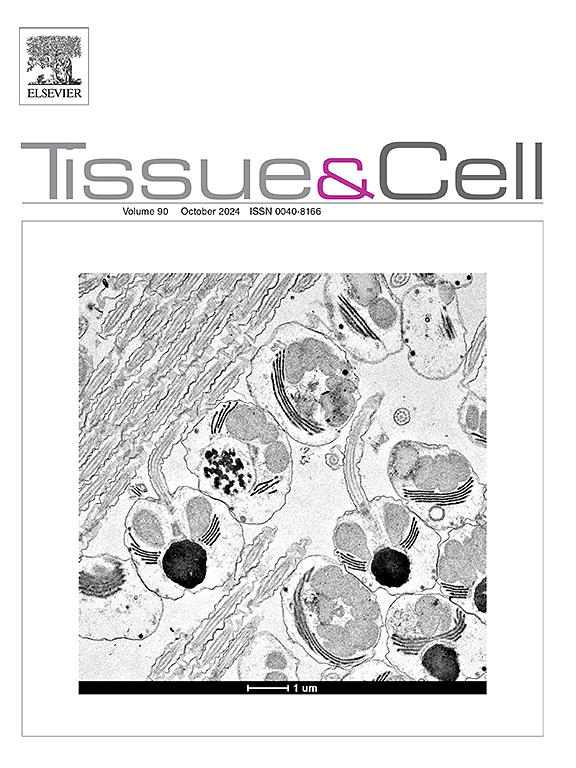The role of TRPV4 in ferroptosis in MPP+/MPTP-induced Parkinson’s disease models
IF 2.7
4区 生物学
Q1 ANATOMY & MORPHOLOGY
引用次数: 0
Abstract
Background
Transient receptor potential vanilloid 4 (TRPV4) is a nonselective calcium-permeable cation channel. Our previous study revealed that TRPV4 mediates endoplasmic reticulum (ER) stress and inflammation, leading to the loss of dopamine neurons in 1-methyl-4-phenyl-1,2,3,6-tetrahydropyridine (MPTP)-induced Parkinson’s disease (PD) model mice.
Objective
The aim of the present study was to investigate the molecular role of TRPV4 in ferroptosis in PD models.
Methods
We used GSK2193874 (an inhibitor of TRPV4) and siRNA targeting TRPV4 to explore the role of TRPV4 in iron transportation, the production of reactive oxygen species (ROS) and oxidative stress in 1-methyl-4-phenylpyridinium ion (MPP+)-treated PC12 cells by H2DCFDA, CCK-8, ELISA and western blot. In a PD mouse model, the intracerebral injection of adeno-associated virus (AAV) was used to knockdown or upregulate TRPV4 expression following the intraperitoneal injection of MPTP and GSK2193874. We used Perl’s iron staining and western blot to detect alterations in iron-positive cells and ferroptosis-associated molecules in the substantia nigra (SN).
Results
We found that silencing TRPV4 increased the expression of glutathione peroxidase 4 (GPX4) and ferritin heavy chain (FTH1), decreased divalent metal transporter 1 (DMT1), and alleviated the excessive ROS and oxidative stress in MPP+-induced PC12 cells. Moreover, TRPV4 regulated the accumulation of iron in the SN and ferroptosis-associated signalling pathways in PD mice.
Conclusions
TRPV4 plays a key role in MPP+/MPTP-induced ferroptosis. Our results indicate that the downregulation of TRPV4 may a represent promising treatment for PD through the inhibition of ferroptosis.
TRPV4在MPP+/ mptp诱导的帕金森病模型中铁下垂的作用
瞬时受体电位香草蛋白4 (TRPV4)是一种非选择性钙渗透阳离子通道。我们之前的研究表明,TRPV4介导内质网(ER)应激和炎症,导致1-甲基-4-苯基-1,2,3,6-四氢吡啶(MPTP)诱导的帕金森病(PD)模型小鼠多巴胺神经元的丢失。目的探讨TRPV4在PD模型铁下垂中的分子作用。方法利用TRPV4抑制剂GSK2193874和靶向TRPV4的siRNA,通过H2DCFDA、CCK-8、ELISA和western blot等方法,探讨TRPV4在1-甲基-4-苯基吡啶离子(MPP+)处理的PC12细胞中铁转运、活性氧(ROS)产生和氧化应激中的作用。在PD小鼠模型中,在腹腔注射MPTP和GSK2193874后,用脑内注射腺相关病毒(AAV)来下调或上调TRPV4的表达。我们采用Perl 's铁染色和western blot检测黑质(SN)中铁阳性细胞和凋亡相关分子的变化。结果沉默TRPV4可提高MPP+诱导的PC12细胞谷胱甘肽过氧化物酶4 (GPX4)和铁蛋白重链(FTH1)的表达,降低二价金属转运蛋白1 (DMT1)的表达,减轻过量的ROS和氧化应激。此外,TRPV4调节PD小鼠SN和凋亡相关信号通路中铁的积累。结论strpv4在MPP+/ mptp诱导的铁下垂中起关键作用。我们的研究结果表明,下调TRPV4可能是通过抑制铁下垂来治疗PD的一种有希望的方法。
本文章由计算机程序翻译,如有差异,请以英文原文为准。
求助全文
约1分钟内获得全文
求助全文
来源期刊

Tissue & cell
医学-解剖学与形态学
CiteScore
3.90
自引率
0.00%
发文量
234
期刊介绍:
Tissue and Cell is devoted to original research on the organization of cells, subcellular and extracellular components at all levels, including the grouping and interrelations of cells in tissues and organs. The journal encourages submission of ultrastructural studies that provide novel insights into structure, function and physiology of cells and tissues, in health and disease. Bioengineering and stem cells studies focused on the description of morphological and/or histological data are also welcomed.
Studies investigating the effect of compounds and/or substances on structure of cells and tissues are generally outside the scope of this journal. For consideration, studies should contain a clear rationale on the use of (a) given substance(s), have a compelling morphological and structural focus and present novel incremental findings from previous literature.
 求助内容:
求助内容: 应助结果提醒方式:
应助结果提醒方式:


